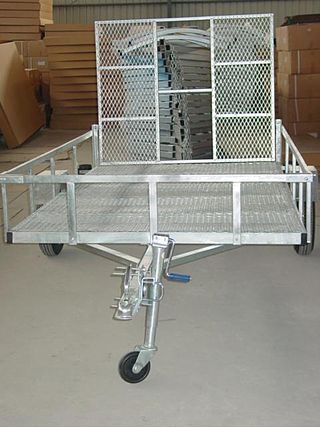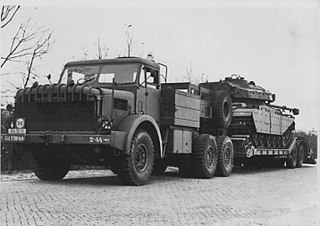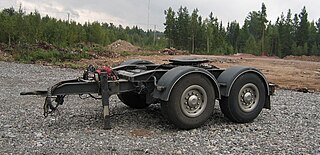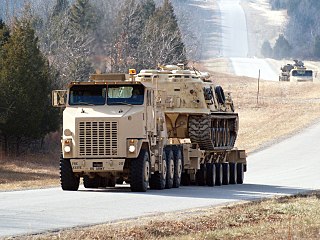
A semi-trailer truck, is the combination of a tractor unit and one or more semi-trailers to carry freight. A semi-trailer attaches to the tractor with a type of hitch called a fifth wheel.

A tractor is an engineering vehicle specifically designed to deliver a high tractive effort at slow speeds, for the purposes of hauling a trailer or machinery such as that used in agriculture, mining or construction. Most commonly, the term is used to describe a farm vehicle that provides the power and traction to mechanize agricultural tasks, especially tillage, and now many more. Agricultural implements may be towed behind or mounted on the tractor, and the tractor may also provide a source of power if the implement is mechanised.

A trailer is an unpowered vehicle towed by a powered vehicle. It is commonly used for the transport of goods and materials.

A dump truck, known also as a dumping truck, dump trailer, dumper trailer, dump lorry or dumper lorry or a dumper for short, is used for transporting materials for construction as well as coal. A typical dump truck is equipped with an open-box bed, which is hinged at the rear and equipped with hydraulic rams to lift the front, allowing the material in the bed to be deposited ("dumped") on the ground behind the truck at the site of delivery. In the UK, Australia, South Africa and India the term applies to off-road construction plants only and the road vehicle is known as a tip lorry, tipper lorry, tipper truck, tip truck, tip trailer or tipper trailer or simply a tipper.

The Mighty Antar was a heavy-duty 6×4 tractor unit built by Thornycroft from the late 1940s onwards. For some decades it was the standard tank transporter of the British Army and was also used by other nations. It was powered by a shortened V8 land version of the V12 Meteor engine, derived from the Merlin and modified to run on diesel, known as the Rolls-Royce Meteorite.
Scammell Lorries Limited was a British manufacturer of trucks, particularly specialist and military off-highway vehicles, between 1921 and 1988. From 1955 Scammell was part of Leyland Motors.

A dolly is an unpowered vehicle designed for connection to a tractor unit, truck or prime mover vehicle with strong traction power.

The M19 Tank Transporter was a heavy tank transporter system used in World War II and into the 1950s. It consisted of a 12-ton 6×4 M20 Diamond T Model 980 truck and companion 12-wheel M9 trailer.

A tractor unit, also known as a truck unit, lorry unit, power unit, prime mover, ten-wheeler, semi-tractor, semi-truck, semi-lorry, tractor cab, truck cab, lorry cab, big rig tractor, big rig truck or big rig lorry or simply a tractor, truck, lorry, semi, big rig or rig, is a characteristically heavy-duty towing engine that provides motive power for hauling a towed or trailered load. These fall into two categories: heavy- and medium-duty military and commercial rear-wheel-drive semi-tractors used for hauling semi-trailers, and very heavy-duty typically off-road-capable, often 6×6, military and commercial tractor units, including ballast tractors.

A semi-trailer is a trailer without a front axle. The combination of a semi-trailer and a tractor truck is called a semi-trailer truck.

A heavy hauler is a very large transporter for moving oversize loads too large for road travel without an escort and special permit.

A ballast tractor is a specially weighted tractor unit of a heavy hauler combination. It is designed to utilize a drawbar to pull or push heavy or exceptionally large trailer loads which are loaded in a hydraulic modular trailer. When feasible, lowboy-style semi-trailers are used to minimize the height of a load's center of mass. Typical drivetrains are 6×4 and 6×6, but 8×6 and 8×8 are also available. Typical ballast tractor loads include oil rig modules, bridge sections, buildings, ship sections, and industrial machinery such as generators and turbines.

A drawbar is a solid coupling between a hauling vehicle and its hauled load. Drawbars are in common use with rail transport; road trailers, both large and small, industrial and recreational; and agricultural equipment.

Eight-wheel drive, often notated as 8WD or 8×8, is a drivetrain configuration that allows all eight wheels of an eight-wheeled vehicle to be drive wheels simultaneously. Unlike four-wheel drive drivetrains, the configuration is largely confined to heavy-duty off-road and military vehicles, such as armored vehicles, tractor units or all-terrain vehicles such as the Argo Avenger.

A lowboy is a semi-trailer with two drops in deck height: one right after the gooseneck and one right before the wheels. This allows the deck to be extremely low compared with other trailers. It offers the ability to carry legal loads up to 12 ft (3.66 m) tall, which other trailers cannot. Lowboys are used to haul heavy equipment such as bulldozers and large industrial equipment.
The SLT 56 is a heavy duty tractor unit and tank transporter currently in use by the German Army.

The Oshkosh M1070 is a U.S. Army tank transporter tractor unit. The primary purpose of this combination for the U.S. Army is the transport of the M1 Abrams tank.

A hydraulic modular trailer (HMT) is a special platform trailer unit which feature swing axles, hydraulic suspension, independently steerable axles, two or more axle rows, compatible to join two or more units longitudinally and laterally and uses power pack unit (PPU) to steer and adjust height. These trailer units are used to transport oversized load, which are difficult to disassemble and are overweight. These trailers are manufactured using high tensile steel, which makes it possible to bear the weight of the load with the help of one or more ballast tractors which push and pull these units via drawbar or gooseneck this combination of tractor and trailer is also termed as heavy hauler.

Nicolas Tractomas is a heavy-duty built-to-order ballast tractor specifically to tow hydraulic modular trailers and road trains used for movement of oversize loads manufactured by French manufacturer Nicolas Industrie based in Auxerre. The tractor was bespoke build with preferred engine, gearbox, drivetrain and ballast with a Renault kerax cabin. The production of the tractor began in 1979 and lasted till 2016. The TR1010 D100 model of the tractor was awarded the Guinness World Record in 2015 for the largest road truck in the world, weighing 71 tons.































